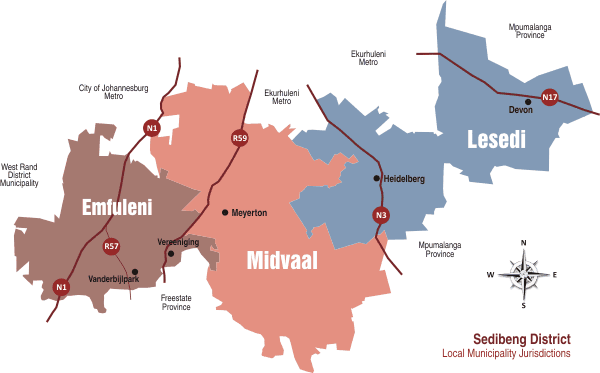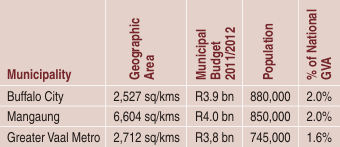| |
Background
The evolution of the current Sedibeng District Municipality lies in the consolidation of the urban concentrations of the city of Vereeniging and town of Vanderbijlpark, Meyerton and Heidelberg as well as the townships of Evaton, Sebokeng, Sharpeville, Sicielo, Ratanda and others. The Sedibeng District Municipality came into effect after the 2000 local elections as a Category B municipality that included three local municipalities; Emfuleni, Midvaal and Lesedi.
Following the first local election in 1995, the Lekoa-Vaal Metropolitan Council was established and the Sedibeng District Municipality was the successor in law following the 2000 local elections. At the time of the establishment of the Sedibeng District, the region was considered an 'Aspirant Metro'. Several developments since 2000 have revived the aspirations of the region towards being demarcated as a Metropolitan area.
A major and critical process that will unfold during the GDS 2 period will be the realization of the vision of transforming the Sedibeng Region into a single Metropolitan City. This vision emanates from the proven view that many of the region's apartheid legacy problems, particularly those of a socio-economic nature, will best be tackled by one large and cohesive institutional body.
The move towards a single regional authority is advanced,on the one hand, due to a number of inefficiencies that are clear in the operations between one district and three local municipalities in Sedibeng, and on the other hand, the fact that there is a large body of evidence in support of service delivery improvement through single metropolitan authorities.
The view of establishing a single city region was confirmed through two study tours that were carried out by the Sedibeng District Municipality to Buffalo City and Mangaung. Both of these cities are similar to Sedibeng in terms of geography, population density, and economic size. In both instances what was learned made the case for Sedibeng as a single regional authority, even stronger. Although the study tour highlighted the challenging road towards a single city, it confirmed that the financial benefits (just alone from the National Treasury allocation to Metros), makes it a viable proposition.
The transformation of the Sedibeng District Municipality and its locals into a single metropolitan city is a complex project, which is essentially led in the first instance, through the demarcation process. The Gauteng Department of Local Government and Housing has already made the necessary demarcation submissions to the Municipal Demarcation Board (in December 2011). In May 2013 the Demarcation Board will publish its submissions on the outer boundaries of Sedibeng. Between now and then a process of iterations and consultations will take place. The outer boundary will be a critical determination in whether Sedibeng will qualify as a single metropolitan authority, and thus vigilance around our inputs will be critical. Success in this area will lead to an intensive process of merging all the powers, functions, structures, processes, systems and people into one legal institution. This work can commence formally once the Municipal Demarcation Board decision is made and should result in the full implementation of a single metropolitan municipality by May 2016, the end of the phase of GDS2.
Motivations for a Metropolitan System
The departure point for a future Metro was to take the Sedibeng District (and its current demarcation) as the possible proposal for Metro. Extensive analysis and consultations have led to the realisation that a more feasible demarcation for a future Metro would be the consolidation of the current Emfuleni Local Municipality and the Midvaal Local Municipality.
A comparative analysis of the most recent areas that have been awarded Metropolitan status, ie Mangaung and Buffalo City, show that the proposed Metro would be comparable in the keys areas of geographic size, municipal budgets, population and economic contribution.

Benefits of a Metro System of Governance
The establishment of the Greater Vaal Metropolitan River City would have several benefits that would include amongst others the following:
- The new municipality would be a geographic consolidation of highly urbanised areas of rapid growth and development. This would include the Vereeniging, Vanderbijlpark, Sharpeville node that has seen rapid development in the last 5 years. On the medium term development horizon lies projects such as the Vereeniging-Vanderbijlpark Waterfront development, several developments in Sharpeville, upgrading to the Vereeniging CBD, development of a logistics hub in Vanderbijlpark etc. The development of this node is in close proximity to the R59 corridor which has also seen rapid development in the last few years. The imminent construction of a new Regional Sewer Scheme (R4bn) would underpin the growth and development. The Vaal River / Vaal Dam would remain the anchor natural resource that would drive the future development of the new Metro.
- Large scale residential development projects for Doornkuil (Savanah City), Eye of Africa and Mamello, amongst others, would soon lay down new markers for urban concentrations. The possibilities of new town and cities, new CBD's and an a diversification of the regional economy, from the predominantly steel manufacturing sector, is the best long-term security that the people of the area could be afforded.
- The name 'Greater Vaal Metropolitan River City' is not a convenient label but has evolved over many years as residents have been clamouring for the reclamation of the name 'Vaal' which is deeply entrenched in the cultural and historical roots of the area. At the Growth and Development Summit of 30 November 2011, the name was formerly endorsed by the stakeholders of the area.
- The Gauteng Province is moving inexorably towards a Global City Region made up exclusively of Metropolitan areas. The Greater Vaal Metro would fit appropriately into such a system.
- The mobilityof people, goods and services, into and out of the new Metro on a daily basis along the N1, R59, R82 (scheduled for immediate upgrade by Gauteng province), Golden Highway, and along the railway networks provides strong motivation for a Metro.
Conclusion Several strong arguments converge to support the proposal for a 'Greater Vaal Metropolitan River City' in the southern part of the Gauteng Province. The Sedibeng District and its local municipalities have been pro-actively engaging on the best options for the long term prosperity of region. It is believed that the best vehicle for addressing the economic and social challenges of the area, would be a Greater Vaal Metropolitan River City as set out in this summary.
|
|